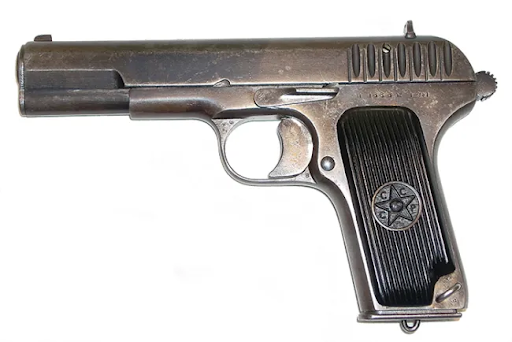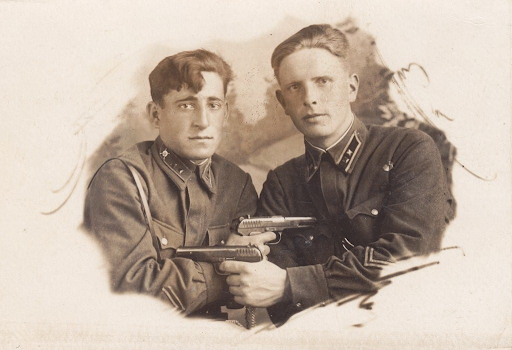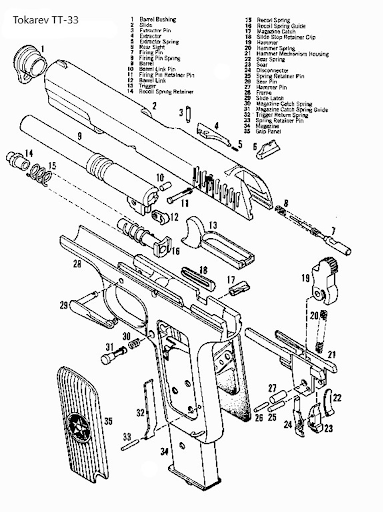The TT-33
History and Design
The TT-33 (Tula-Tokarev) pistol was designed by Fedor Tokarev in 1933 and was an improved model of his earlier TT-30 (designed 1930). They are chambered in 7.62x25mm Tokarev, the same caliber as the PPSH-41 and later the PPS-43. They had an effective range of 50m and a muzzle velocity of 450m/s while weighing in at about 2 lbs and 8 inches in length. Both pistols were single-action, semi-automatic pistols utilizing a locked breech, short recoil-operated system. Neither pistol had a safety catch, instead opting for a half-cock system that would prevent the trigger from being pulled while in position. The TT-30 and TT-33 both used 8 round single stack box magazines.
They owe their design to the FN Model 1903 and Browning M1911, inside and out. Tokarev made improvements that made the TT-30 series much simpler and easy to produce such as bundling the hammer and sear together into an easily removable assembly on the frame as well as having feed lips machined into the receiver. He also used the M1911’s short recoil barrel-tilting system. The TT-33 went a few steps further than the TT-30 with a further improved trigger, frame, and the inclusion of machined locking lugs around the entire circumference of the barrel instead of merely top mounted.
Production and Copies
Initially, the TT-30 series was supposed to replace the Nagant M1895 revolver. The TT series never fully replaced the Nagant and was instead used in conjunction due to the outbreak of war and the already vast availability of the revolver. The TT-30 was made the standard sidearm of the Red Army in 1930 and between 1930-36 about 93,000 were produced. After improvements, the TT-33 replaced the previous model. From 1933-1954/5 about 1.7 million were produced at the Tula and Izhevsk plants. Eventually, the TT-33 was replaced by the Makarov in 1952 and production in Russia ceased a few years later. Other countries such as Poland, Romania, Yugoslavia, Hungary, etc. opted to design and produce their own copies of the TT-33 even after production ceased in the Soviet Union. Most copies differ only slightly such as having different slide serrations, grips, and other aesthetic variations. Of particular note is the Yugoslavian Zastava M57 clone which is designed with a longer grip for a 9 round, instead of an 8 round magazine. Many of the TT-33s and its clones in the states come with an added safety toggle switch required upon import. Another important note is hammers. Wartime Russian produced TTs usually have a “smooth” hammer while many have a distinct “hump”. This difference can pose a considerable challenge when attempting to blank adapt for reenacting purposes.

Issuance and Use
TTs were generally issued to commanders and those of higher rank first. The rest trickled their way down the ranks as available, otherwise the M1895 Nagant Revolver was issued. Originally it was thought that the TT-33 could be used by armored personnel but it was found that the reciprocating slide prevented the pistol from being adequately fired through Soviet tank ports in combat. Since the TT only has an effective range of 50 meters they were used primarily in close quarters combat and more desperate circumstances. There are at least a few famous photos of the TT being used to rally the fighting spirit of soldiers to charge forward.
Maintenance and Teardown
Most, if not all, military surplus Tokarev ammo is highly corrosive. When cleaning, use a solvent that neutralizes these corrosive salts. Ballistol, CLP, and G96 are perfect for such a task. Cleaning as soon as possible after shooting is the best method to prevent corrosion or any extra pitting of the barrel. A .308-.30 pistol bore snake helps immeasurably and reduces overall time spent cleaning. Be sure to clean not only the barrel, but any part that is exposed to corrosive residue. Do not over oil or you risk inviting dirt and particles to build up in your firearm. To download a copy of the weapon manual including the 1895 revolver click here. To tear down a TT-33 start by:
- Remove the slide stop retainer clip (this can be easily done with the help of a spent casing).
- Remove the slide latch, this allows the slide to move freely.
- Remove the slide from the frame while being careful to hold the recoil spring so it doesn’t fire out of the slide.
- Next, carefully remove the spring retainer, spring, and spring guide from the slide.
- Now the barrel bushing will be loose and can be unscrewed from the slide, pull it off
- Pull the barrel out of the slide.
- Pull the hammer housing mechanism off of the frame.
To put the Tokarev back together after cleaning simply follow these steps
- Place the hammer housing mechanism back in the frame.
- Place the barrel back in the slide, make sure the barrel link is straight up.
- Screw the barrel bushing back onto the slide.
- Carefully insert the spring retainer, spring, and spring guide back under the barrel. Again, make sure that the barrel link is straight up and that the spring guide is flush with the barrel, crescent side down.
- Holding the spring in place, slowly put the frame and slide back together.
- Put the slide latch through the barrel link and frame.
- Slide the slide stop retainer back into place and you are all done!
Sources:
Peterson, P. (2019, December 4). Gun collecting: Tokarev’s TT-33 and its clones. Gun Digest.
Popenker, M. (2014, December 3). Tokarev’s empire: A battle-tested Soviet TT design. Tactical Life
Scarlata, P. S. (2020, March 5). The Tokarev TT33 semiautomatic pistol.
Мой комментарий к записи “Наша дружба и опасна, и трудна!” от Sergeytsvetkov. mikhalgeorgitsh. (2020, September 20).






